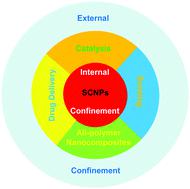当前位置:
X-MOL 学术
›
Mater. Horiz.
›
论文详情
Our official English website, www.x-mol.net, welcomes your feedback! (Note: you will need to create a separate account there.)
Single-chain nanoparticles: opportunities provided by internal and external confinement
Materials Horizons ( IF 13.3 ) Pub Date : 2020-06-25 , DOI: 10.1039/d0mh00846j Ester Verde-Sesto 1, 2, 3 , Arantxa Arbe 1, 2, 3 , Angel J. Moreno 1, 2, 2, 3, 4 , Daniele Cangialosi 1, 2, 2, 3, 4 , Angel Alegría 1, 2, 3, 5, 6 , Juan Colmenero 1, 2, 2, 3, 4 , José A. Pomposo 1, 2, 3, 5, 6
Materials Horizons ( IF 13.3 ) Pub Date : 2020-06-25 , DOI: 10.1039/d0mh00846j Ester Verde-Sesto 1, 2, 3 , Arantxa Arbe 1, 2, 3 , Angel J. Moreno 1, 2, 2, 3, 4 , Daniele Cangialosi 1, 2, 2, 3, 4 , Angel Alegría 1, 2, 3, 5, 6 , Juan Colmenero 1, 2, 2, 3, 4 , José A. Pomposo 1, 2, 3, 5, 6
Affiliation

|
In recent decades, self-confinement effects arising from the folding of individual synthetic polymer chains to single-chain nanoparticles (SCNPs) have been exploited for the construction of efficient enzyme-mimetic catalysts, improved drug delivery nanosystems and innovative sensing nanomaterials, among other uses. Remarkably, the imperfect folding of a unimolecular synthetic chain to a functional soft nano-object resembles – to some extent – the folding of a protein to its native, functional state. However, the huge possibilities that can be deployed by determining how external confinement modulates the structure, dynamics and properties of SCNPs have not been totally appreciated yet. In this article, after considering the opportunites that internal confinement in SCNPs offers for catalysis; encapsulation, transport and delivery of therapeutic cargos; and sensing, targeting and bioimaging applications, as well as other diverse advanced applications, we try to provide a unifying vision of what is the expected effect of external confinement – as imposed under different geometrical constraints as well as in solution, in the melt state, on surfaces and in membranes – on the size, shape and, hence, potential functionality/foreseen applications of SCNPs. We anticipate a plethora of opportunities that open up arising from external confinement of SCNPs: from innovative purification techniques and improved all-polymer nanocomposites, to smart responsive surfaces and new topological nanostructures.
中文翻译:

单链纳米颗粒:内部和外部限制提供的机会
在最近的几十年中,由于将单个合成聚合物链折叠成单链纳米颗粒(SCNP)而产生的自约束效应已被用于构建高效的模拟酶催化剂,改进的药物递送纳米系统和创新的传感纳米材料,以及其他用途。值得注意的是,单分子合成链向功能性软纳米物体的不完美折叠在某种程度上类似于蛋白质向天然功能状态的折叠。但是,通过确定外部约束如何调节SCNP的结构,动力学和特性可以部署的巨大可能性尚未完全被人们认识到。在本文中,考虑了SCNPs内部限制提供催化作用的机会。封装 治疗性货物的运输和交付;以及传感,靶向和生物成像应用,以及其他各种高级应用,我们试图提供统一的视野,即在不同的几何约束以及在熔融状态下在溶液中施加的外部约束的预期效果是什么,在表面和膜上–在SCNP的尺寸,形状以及潜在的功能/可预见的应用上。我们预计,由于SCNP的外部限制,将带来大量机会:从创新的纯化技术和改进的全聚合物纳米复合材料到智能响应表面和新的拓扑纳米结构。我们试图提供一个统一的视野,即在不同的几何约束下以及在溶液中,在熔融状态下,在表面和在膜上施加的外部约束对尺寸,形状以及潜在的潜在影响是什么SCNP的功能/可预见的应用。我们预计,由于SCNP的外部限制,将带来大量机会:从创新的纯化技术和改进的全聚合物纳米复合材料到智能响应表面和新的拓扑纳米结构。我们试图提供一个统一的视野,即在不同的几何约束下以及在溶液中,在熔融状态下,在表面和在膜上施加的外部约束对尺寸,形状以及潜在的潜在影响是什么SCNP的功能/可预见的应用。我们预计,由于SCNP的外部限制,将带来大量机会:从创新的纯化技术和改进的全聚合物纳米复合材料到智能响应表面和新的拓扑纳米结构。
更新日期:2020-09-01
中文翻译:

单链纳米颗粒:内部和外部限制提供的机会
在最近的几十年中,由于将单个合成聚合物链折叠成单链纳米颗粒(SCNP)而产生的自约束效应已被用于构建高效的模拟酶催化剂,改进的药物递送纳米系统和创新的传感纳米材料,以及其他用途。值得注意的是,单分子合成链向功能性软纳米物体的不完美折叠在某种程度上类似于蛋白质向天然功能状态的折叠。但是,通过确定外部约束如何调节SCNP的结构,动力学和特性可以部署的巨大可能性尚未完全被人们认识到。在本文中,考虑了SCNPs内部限制提供催化作用的机会。封装 治疗性货物的运输和交付;以及传感,靶向和生物成像应用,以及其他各种高级应用,我们试图提供统一的视野,即在不同的几何约束以及在熔融状态下在溶液中施加的外部约束的预期效果是什么,在表面和膜上–在SCNP的尺寸,形状以及潜在的功能/可预见的应用上。我们预计,由于SCNP的外部限制,将带来大量机会:从创新的纯化技术和改进的全聚合物纳米复合材料到智能响应表面和新的拓扑纳米结构。我们试图提供一个统一的视野,即在不同的几何约束下以及在溶液中,在熔融状态下,在表面和在膜上施加的外部约束对尺寸,形状以及潜在的潜在影响是什么SCNP的功能/可预见的应用。我们预计,由于SCNP的外部限制,将带来大量机会:从创新的纯化技术和改进的全聚合物纳米复合材料到智能响应表面和新的拓扑纳米结构。我们试图提供一个统一的视野,即在不同的几何约束下以及在溶液中,在熔融状态下,在表面和在膜上施加的外部约束对尺寸,形状以及潜在的潜在影响是什么SCNP的功能/可预见的应用。我们预计,由于SCNP的外部限制,将带来大量机会:从创新的纯化技术和改进的全聚合物纳米复合材料到智能响应表面和新的拓扑纳米结构。



























 京公网安备 11010802027423号
京公网安备 11010802027423号